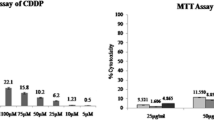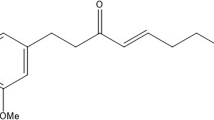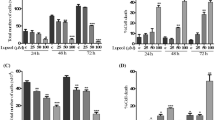Abstract
Purpose
Cervical cancer is characterized as an important public health problem. According to latest estimates, cancer of the cervix is the fourth most common cancer among women. Due to its high prevalence, the search for new and efficient drugs to treat this infection is continuous. The progression of HPV-associated cervical cancer involves the expression of two viral proteins, E6 and E7, which are rapidly degraded by the ubiquitin–proteasome system through the increase in reactive oxygen species generation. Vitamins are essential to human substances, participate in the regulation of metabolism, and facilitate the process of energy transfer.
Methods
Some early studies have indicated that vitamin K3 exerts antitumor activity by inducing cell death by apoptosis through an increase in the generation of reactive oxygen species. Thus, we evaluated the antiproliferative effect and a likely mechanism of action of vitamin K3 against cervical epithelial cells transformed by HPV 16 (SiHa cells) assessing the production of total ROS, the mitochondrial membrane potential, the cell morphology, the cell volume, and the cell membrane integrity.
Results
Our results show that vitamin K3 induces an increase in ROS production in SiHa cells, triggering biochemical and morphological events, such as depolarization of mitochondrial membrane potential and decreasing cell volume.
Conclusion
Our data showed that vitamin K3 generates an oxidative imbalance in SiHa cells, leading to mechanisms that induce cell death by apoptosis.






Similar content being viewed by others
Abbreviations
- ANOVA:
-
One-way analysis of variance
- CCCP:
-
Carbonyl cyanide 3- clorophenylhydrazone
- DHR:
-
Dihydrorhodamine 123
- DIC:
-
Differential interference contrast microscopy
- DMEM:
-
Dulbecco’s modified Eagle’s medium
- DMSO:
-
Dimethylsulfoxide
- EDTA:
-
Ethylenediaminetetraacetic acid
- FACS:
-
Calibur flow cytometer
- FSC-H:
-
Forward light scatter
- H2DCF-DA:
-
2′,7′-dichlorodihydrofluorescein diacetate
- HPV 16:
-
SiHa cells
- HPV:
-
Human papillomavirus
- IC50:
-
50 % inhibitory concentration
- IC90:
-
90 % inhibitory concentration
- IV:
-
Index of variation
- MTT:
-
3-(4,5-dimethylthiazol-2-yl)-2,5-diphenyltetrazolium bromide
- OD:
-
Optical density
- PI:
-
Propidium idodite
- PSN:
-
Penicillin–streptomycin–neomycin antibiotic
- RFU:
-
Relative fluorescence units
- Rh123:
-
Rhodamine123
- ROS:
-
Reactive oxygen species
- VERO:
-
Cercopithecus aethiops
- ΔΨm:
-
Mitochondrial membrane potential assay
References
INCA (2012) Incidência de Câncer no Brasil. http://www.inca.gov.br/estimativa/2012/index.asp?ID=2015. Accessed 10 Oct 2015
Spangle JM, Munger K (2010) The human papillomavirus type 16 E6 oncoprotein activates mTORC1 signaling and increases protein synthesis. J Virol 84(18):9398–9407. doi:10.1128/JVI.00974-10 (Epub 2010Jul 14)
Khan S, Jaffer NN, Khan MN, Rai MA, Shafiq M, Ali A, Pervez S, Khan N, Aziz A, Ali SH (2007) Human papillomavirus subtype 16 is common in Pakistani women with cervical carcinoma. Int J Infect Dis 11:313–317
Khan AM, Singer A (2008) Biomarkers in cervical precancer management: the new frontiers. Future Oncol 4:515–524. doi:10.2217/14796694.4.4.515
Jing K, Shin S, Jeong S, Kim S, Song KS, Park JH, Heo JY, Seo KS, Park SK, Kweon GR, Wu T, Park JI, Lim K (2014) Docosahexaenoic acid induces the degradation of HPV E6/E7 oncoproteins by activating the ubiquitin-proteasome system. Cell Death Dis 5:e1524. doi:10.1038/cddis.2014.477
Reinstein E, Scheffner M, Oren M, Ciechanover A, Schwartz A (2000) A Degradation of the E7 human papillomavirus oncoprotein by the ubiquitin-proteasome system: targeting via ubiquitination of the N-terminal residue. Oncogene 19:5944–5950
Stewart D, Kazemi S, Li S, Massimi P, Banks L, Koromilas AE, Matlashewski G (2004) Ubiquitination and proteasome degradation of the E6 proteins of human papillomavirus types 11 and 18. J Gen Virol 85:1419–1426
Kitano T, Yoda H, Tabata K, Miura M, Toriyama M, Motohashi S, Suzuki T (2012) Vitamin K3 analogs induce selective tumor cytotoxicity in neuroblastoma. Biol Pharm Bull 35:617–623
Yang CR, Liao WS, Wu YH, Murugan K, Chen C, Chao JI (2013) CR108, a novel vitamin K3 derivative induces apoptosis and breast tumor inhibition by reactive oxygen species and mitochondrial dysfunction. Toxicol Appl Pharmacol 273:611–622. doi:10.1016/j.taap.2013.10.007 (Epub 2013 Oct 12)
Matzno S, Yamaguchi Y, Akiyoshi T, Nakabayashi T, Matsuyama K (2008) An attempt to evaluate the effect of vitamin K3 using as an enhancer of anticancer agents. Biol Pharm Bull 31:1270–1273
Monteiro JP, Martins AF, Nunes C, Morais CM, Lucio M, Reis S, Pinheiro TJ, Geraldes CF, Oliveira PJ (1828) Jurado AS (2013) A biophysical approach to menadione membrane interactions: relevance for menadione-induced mitochondria dysfunction and related deleterious/therapeutic effects. Biochim Biophys Acta 8:1899–1908. doi:10.1016/j.bbamem.2013.04.006 (Epub 2013 Apr 13)
Bonilla-Porras AR, Jimenez-Del-Rio M, Velez-Pardo C (2011) Vitamin K3 and vitamin C alone or in combination induced apoptosis in leukemia cells by a similar oxidative stress signalling mechanism. Cancer cell international 10(11):19. doi:10.1186/1475-2867-11-19
Kroemer G, Galluzzi L, Vandenabeele P, Abrams J, Alnemri ES, Baehrecke EH, Blagosklonny MV, El-Deiry WS, Golstein P, Green DR, Hengartner M, Knight RA, Kumar S, Lipton SA, Malorni W, Nunez G, Peter ME, Tschopp J, Yuan J, Piacentini M, Zhivotovsky B, Melino G (2009) Classification of cell death: recommendations of the Nomenclature Committee on Cell Death 2009. Cell Death Differ 16(1):3–11. doi:10.1038/cdd.2008.150 (Epub 2008 Oct 10)
Held NM, Houtkooper RH (2015) Mitochondrial quality control pathways as determinants of metabolic health. Bioessays 37(8):867–876. doi:10.1002/bies.201500013 (Epub 2015 May 26)
Barbour JA, Turner N (2014) Mitochondrial stress signaling promotes cellular adaptations. Int J Cell Biol 2014:156020. doi:10.1155/2014/156020 (Epub 2014 Jan 22)
Franco R, Cidlowski JA (2009) Apoptosis and glutathione: beyond an antioxidant. Cell Death Differ 16:1303–1314. doi:10.1038/cdd.2009.107 (Epub 2009 Aug 7)
Chaturvedi AK, Engels EA, Gilbert ES, Chen BE, Storm H, Lynch CF, Hall P, Langmark F, Pukkala E, Kaijser M, Andersson M, Fossa SD, Joensuu H, Boice JD, Kleinerman RA, Travis LB (2007) Second cancers among 104,760 survivors of cervical cancer: evaluation of long-term risk. J Natl Cancer Inst 99:1634–1643. doi:10.1093/jnci/djn087
Yee GP, de Souza P, Khachigian LM (2013) Current and potential treatments for cervical cancer. Curr Cancer Drug Targets 13:205–220
Chao A, Lin CT, Lai CH (2014) Updates in systemic treatment for metastatic cervical cancer. Curr Treat Options Oncol 15:1–13. doi:10.1007/s11864-013-0273-1
Ye J, Yin L, Xie P, Wu J, Huang J, Zhou G, Xu H, Lu E, He X (2015) Antiproliferative effects and molecular mechanisms of troglitazone in human cervical cancer in vitro. Onco Targets Ther 8:1211–1218. doi:10.2147/OTT.S79899 (eCollection 2015)
Perera RM, Bardeesy N (2011) Cancer: when antioxidants are bad. Nature 475(7354):43–44. doi:10.1038/475043a
Murphy MP (2009) How mitochondria produce reactive oxygen species. Biochem J 417(1):1–13. doi:10.1042/BJ20081386
Koppenol WH, Bounds PL, Dang CV (2011) Otto Warburg’s contributions to current concepts of cancer metabolism. Nat Rev Cancer 11(5):325–337. doi:10.1038/nrc3038 (Epub 2011 Apr 14)
Hsu PP, Sabatini DM (2008) Cancer cell metabolism: warburg and beyond. Cell 134:703–707
Lim HY, Ho QS, Low J, Choolani M, Wong KP (2011) Respiratory competent mitochondria in human ovarian and peritoneal cancer. Mitochondrion 11(3):437–443. doi:10.1016/j.mito.2010.12.015 (Epub 2011 Jan 3)
Scott DA, Richardson AD, Filipp FV, Knutzen CA, Chiang GG, Ronai ZA, Osterman AL, Smith JW (2011) Comparative metabolic flux profiling of melanoma cell lines: beyond the Warburg effect. J Biol Chem 286(49):42626–42634. doi:10.1074/jbc.M111.282046 (Epub 2011 Oct 13)
Busk M, Horsman MR, Kristjansen PE, van der Kogel AJ, Bussink J, Overgaard J (2008) Aerobic glycolysis in cancers: implications for the usability of oxygen-responsive genes and fluorodeoxyglucose-PET as markers of tissue hypoxia. Int J Cancer 122(12):2726–2734. doi:10.1002/ijc.23449
Bonuccelli G, Tsirigos A, Whitaker-Menezes D, Pavlides S, Pestell RG, Chiavarina B, Frank PG, Flomenberg N, Howell A, Martinez-Outschoorn UE, Sotgia F, Lisanti MP (2010) Ketones and lactate “fuel” tumor growth and metastasis: Evidence that epithelial cancer cells use oxidative mitochondrial metabolism. Cell Cycle 9(17):3506–3514
Ralph SJ, Low P, Dong L, Lawen A, Neuzil J (2006) Mitocans: mitochondrial targeted anti-cancer drugs as improved therapies and related patent documents. Recent Pat Anticancer Drug Discov 1:327–346
Akiyoshi T, Matzno S, Sakai M, Okamura N, Matsuyama K (2009) The potential of vitamin K3 as an anticancer agent against breast cancer that acts via the mitochondria-related apoptotic pathway. Cancer Chemother Pharmacol 65:143–150. doi:10.1007/s00280-009-1016-7 (Epub 2009 May 16)
Paul A, Das S, Das J, Samadder A, Bishayee K, Sadhukhan R, Khuda-Bukhsh AR (2013) Diarylheptanoid-myricanone isolated from ethanolic extract of Myrica cerifera shows anticancer effects on HeLa and PC3 cell lines: signalling pathway and drug-DNA interaction. J Integr Med 11:405–415. doi:10.3736/jintegrmed2013057
Igney FH, Krammer PH (2002) Death and anti-death: tumour resistance to apoptosis. Nat Rev Cancer 2:277–288
Acknowledgments
This study was supported by Conselho Nacional de Desenvolvimento Científico e Tecnológico (CNPq), Coordenação de Aperfeiçoamento de Pessoal de Nível Superior (Capes) e Fundação Araucária.
Author information
Authors and Affiliations
Corresponding author
Ethics declarations
Ethical standards
This study was funded by Conselho Nacional de Desenvolvimento Científico e Tecnológico (CNPq), Coordenação de Aperfeiçoamento de Pessoal de Nível Superior (Capes), Financiadora de Estudos e Projetos, Fundação Araucária. Programa de Pós Graduação em Biociências e Fisiopatologia da Universidade Estadual de Maringá, and Complexo de Centrais de Apoio a Pesquisa–UEM.
Conflict of interest
All authors have no conflict of interest.
Human participants
This article does not contain any studies with human participants or animals performed by any of the authors.
Rights and permissions
About this article
Cite this article
de Carvalho Scharf Santana, N., Lima, N.A., Desoti, V.C. et al. Vitamin K3 induces antiproliferative effect in cervical epithelial cells transformed by HPV 16 (SiHa cells) through the increase in reactive oxygen species production. Arch Gynecol Obstet 294, 797–804 (2016). https://doi.org/10.1007/s00404-016-4097-7
Received:
Accepted:
Published:
Issue Date:
DOI: https://doi.org/10.1007/s00404-016-4097-7




